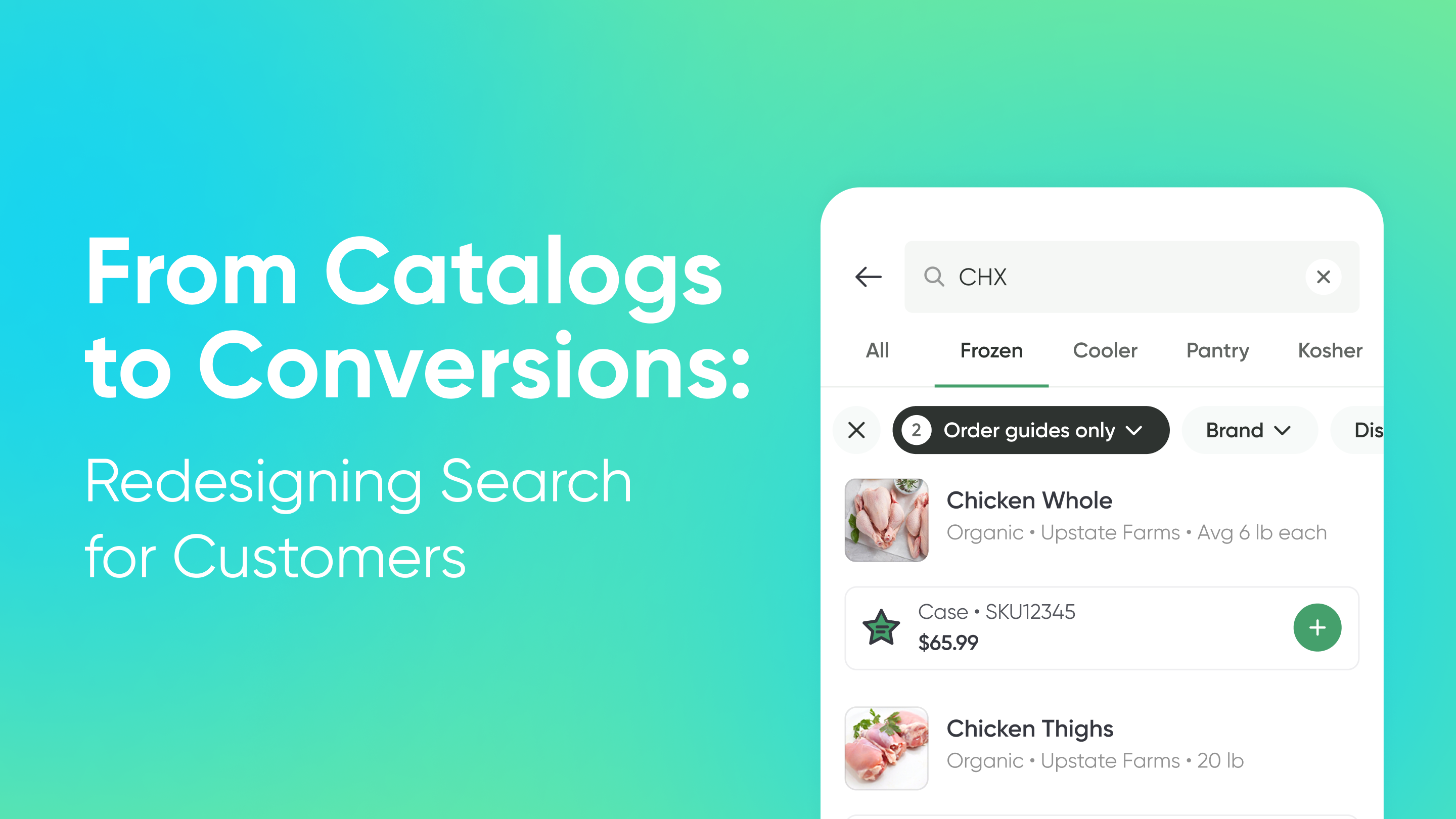At Pepper, we believe search isn’t just a feature. It’s the feature.
It’s the starting point of almost every ordering experience. It’s the first thing your customers do when they log in. And it’s the key to whether or not they actually place an order.
In an industry where product names aren’t standardized, where operators search using shorthand, and where catalogs run thousands of SKUs deep, good search isn’t just nice to have; it’s the difference between a smooth, self-service experience and a support ticket.
That’s why we’ve made search our most important product investment this year. We’re reimagining the entire experience; from how our system understands industry lingo to how we surface the right results faster, and with more context. And we’re doing it all with one goal in mind: making it easier for DSRs and operators to find what they need, when they need it.
We’re Building a Search Experience That Speaks Your Language
Over the past year, we’ve been listening closely to our distributors. We looked at real customer feedback, search logs, and the ways DSRs and operators actually look for products. The takeaway?
Foodservice folks don’t search like ecommerce shoppers.
Instead of typing “boneless, skinless chicken breast,” they type:
- “CHX”
- “BLSL”
- “chx breast”
Even custom slang - some of which only their team uses. So we built a system to keep up.
Today, Pepper supports over 1,000 carefully curated synonym sets - each designed to reflect how people in the foodservice world really speak. In total, these sets represent well over 10,000 sets common shorthand terms.
We’ve made sure it works both ways:
- If your catalog says “CHX drumsticks,” and your customer types “chicken,” they’ll still find it.
- If your ERP uses internal shorthand, Pepper knows how to decode that too.
And for distributors with unique naming conventions? We can create custom synonym logic just for you.
Precision > Guesswork
Search isn’t about throwing spaghetti at the wall. In fact, we’ve done the opposite.
We started with over 20,000 candidate terms—and carefully narrowed that down to a clean, reliable set of synonyms that won’t confuse or mislead the user.
Why? Because overcorrecting can be just as harmful. A shorthand like “FR” might mean “fresh,” “fried,” or “French”- depending on the context. We avoid terms like that unless we’re absolutely confident they’ll return accurate, helpful results.
It’s all about solving more problems than we create.
Helping Users Navigate Large Catalogs with Confidence
Distributors today carry thousands of SKUs. Even a well-typed search can return hundreds of results. That’s not helpful—it’s overwhelming.
That’s why we’re rolling out a new dynamic filter system, designed to give users a way to slice through large result sets and find what they’re looking for, fast.
Here’s what’s new:
- Contextual filters based on the product category
- Facet counts that show how many items live under each filter (e.g., fresh, frozen, kosher, etc.)
Let’s say a customer types “chicken.” Now, they can:
- See that there are 47 frozen options and 12 kosher items
- Click “Frozen”
- Then click “Kosher”
- And instantly land on a manageable, relevant list of products
It’s fast, intuitive, and built to support both seasoned re-orderers and curious first-time buyers.
Why This Matters: Fewer Frustrations, More Orders
When customers can’t find what they’re looking for, they stop using the tool. Or worse—they call their rep.
That means:
- Lost self-service orders
- More time wasted for reps
- A weaker ecommerce experience overall
With better search:
- Operators get what they need—without calling or texting a rep
- Reps spend less time looking up codes and more time building relationships
- Distributors see higher digital adoption and conversion
In fact, in 2025 alone, we’ve already improved search conversion rates by 12.5%. That means users who search are now significantly more likely to place an order than they were just a few months ago.
Optimizing Search for Different Workflows
We also know that not all search behavior is the same. Some customers are exploring. Others are reordering.
So we’re refining Pepper’s experience to support both paths:
- Catalog search will focus on surfacing new, relevant items
- Order guide search will prioritize what customers have purchased before
That clarity reduces confusion and makes it easier for users to know where to go based on what they’re trying to do.
This update will roll out quietly—we’re not trying to make a big splash or admit fault. It’s part of our continuous investment in creating a seamless experience.
This Is Just the Start
Search is the beating heart of Pepper’s platform - and it’s never done.
We’ll keep improving:
- Discoverability
- Relevance
- Personalization
- UX performance
Because helping your customers find the right item shouldn’t require a cheat code. It should just work. And with Pepper, it does.
Whether you’re a long-time customer or just starting to explore what our platform can do, know this: we’re here to make item discovery faster, smarter, and easier for everyone who relies on you.
.webp)
Schedule a Pepper Demo today






























.jpg)
